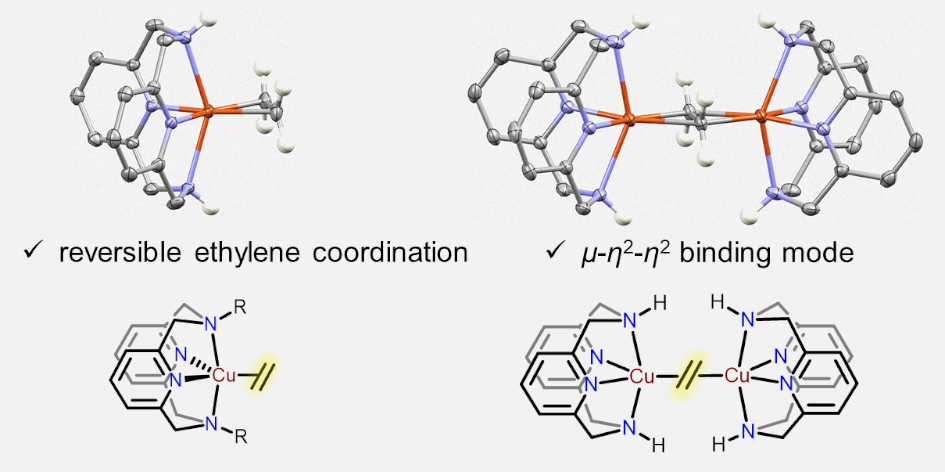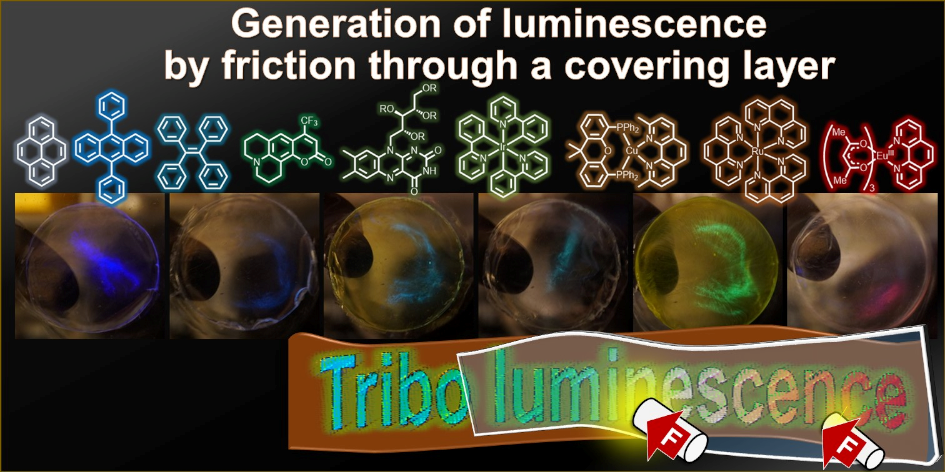FY2022 Annual Report
Coordination Chemistry and Catalysis Unit
Associate Professor Julia Khusnutdinova

Abstract
During this fiscal year (April 2022-March 2023), our group worked on three major directions: mechanoluminescent polymer materials, homogeneous catalysis by base metal complexes, and metal-metal and metal-ligand cooperation in small molecule activation. During this year, Govindarajan reported activation of H2, B-H and Si-H bonds by Pt-Zn bimetallic complexes and together with Shubham, we published an invited Perspective article on heteromultimetallic cooperation in Chemical Science. Dilip has developed a new cationic pincer Fe hydride complex that catalyzed selective semihydrogenation of terminal alkynes and together with Shrin Pal, we were able to get insight into the steric effect on selectivity of semihydrogenation and elucidate the mechanism of this reaction. Shubham in collaboration with Eugene found a simple solvated Ni catalyst that does not require any sophisticted ligand and catalyzes efficient perfluoroalkylation of arenes and heteroarenes using a library of Togni reagents. Continuing on the topic of perfluoroalkylation, Hoan studied Co complexes and their ability to participate in visible light-induced, radical perfluoroalkylation, both stoichiometrically and catalytically. We published two papers on ethylene binding to copper and Ru N2S2-pyridinophane complexes coauthored by many of our former undergraduate interns. Finally, Ayumu published an article on versatile method of generating triboluminescence in polymer films.
This year we could finally host four undergraduate interns: Daria, Mitsuyuki, Hanieh, and Valeriya. Shubham Deolka submitted his PhD thesis with the defense scheduled in May 2023. Ayumu Karimata got promoted to Staff Scientist position from March 2023.
1. Staff
- Dr. Ayumu Karimata, Postdoctoral Scholar
- Dr. Govindarajan Ramadoss, Postdoctoral Scholar
- Dr. Dilip Pandey, Postdoctoral Scholar
- Dr. Janet Bahri, Postdoctoral Scholar
- Dr. Vardhanapu Pavan Kumar, Research Technician
- Richa Bansal, Research Technician
- Shubham Deolka, Graduate Student
- Hoan Dinh, Graduate Student
- Tatiana Gridneva, Graduate Student
- Aleksandr Sorvanov, Graduate Student
- Daria Sherstiukova, Research Intern
- Mitsuyuki Oshiro, Research Intern
- Hanieh Moradi, Research Intern
- Valeriya Frolova, Research Intern
- Kyoko Chinen, Research Unit Administrator
2. Collaborations
2.1 DFT study of the mechanism of Fe-catalyzed hydrogenation
- Type of collaboration: Computational studies of reaction mechanisms
- Researchers: Dr. Shrinwantu Pal (University of Calgary)
3. Activities and Findings
3.1 Homogeneous catalysis by base metals
Developing new catalysts based on inexpensive first row transition metals such as Fe, Ni or Co is one of the main targets in our research as such catalysts would provide an economically viable alternative to precious metal-based systems. We are specifically interested in developing new catalysts for hydrogenation that are based on non-toxic and cheap metals such as iron. Using a new bulky pincer ligand developed in our group, we have developed a new Fe-based catalyst capable of selective semihydrogenation of terminal alkynes to terminal alkenes. These substrates are challenging targets for selective hydrogenation as in many cases, catalyst deactivation or unselective full hydrogenation are observed, while selective semihydrogenation of aryl-substituted terminal alkynes provides a convenient route to synthetically useful styrenes and their derivatives. Our catalyst showed remarkable selectivity leading to hydrogenation of phenylacetylene to styrene, while styrene remained unreacted, by contrast to other structurally similar Fe pincer complexes. To elucidate the origin of such differences, we performed a detailed experimental and computational study in collaboration with visiting scientist Shrinwantu Pal.

Perfluoroalkylation of C-H bonds is another important direction that we developed during this year as introducing fluorine into organic molecules is an important synthetic methodology in pharmaceutical industry and biomedical research. Last year, we reported efficient light-induced, Ni-catalyzed trifluoromethylation using Langlois reagent or Umemoto reagents. This year, we developed a new methodology for introducing a wider range of perfluoroalkyl groups using a combination of simple Ni complex and a library of Togni reagents.

We have also investigated the possiblity of utilizing metals other than nickel for visible light-induced reactivity reporting naphthyridine Co complexes with longer-chain perfluoroethyl groups capable of stoichiometric perfluoroethylation of electron-rich arenes or catalytic reaction in the presence of the Acid Togni reagent.

3.2 Metal-metal cooperation and organometallic reactivity of pyridinophane complexes
One of the major topics in interest in our group is to study metal-metal cooperative reactivity in small molecule activation and metal-metal bonding in multimetallic complexes containing two or more different metals. This year, we have prepared bimetallic Pt/Zn complexes and Pt/Ca complexes and studied metal-metal interactions and reactivity of these new compounds. Pt/Zn complexes were reactive in activation of H2, boranes and silates leading to the formation of hydride-bridged bimetallic complexes, while activation of terminal acetylenes resulted in bridged acetylide formation. Analysis of metal-metal bonding in these complexes showed the presence of bonding Pt...Zn interactions, which were absent in Pt/Ca complexes. The bimetallic Pt...Zn formation was important for H2, B-H and Si-H bond activation and no reactivity was observed in systems where Pt...Zn were not present suggesting the importance of metal-metal interactions in cooperative bond activation.

While studying pyridinophane copper complexes in the context of mechanoresponsive polymer design, we found an interesting reactivity showing that pyridinophane (N4) supported Cu efficiently binds to ethylene forming 1:1 as well as unusual 2:1 complexes. Considering that copper-ethylene binding plays an important role in plant enzymes responsible for fruit ripening, we further studied this intriguing reactivity and reported a series of Cu ethylene complexes. The ethylene binding mode in these complexes was elucidated through computational investigation.

We have also continued studying deprotonation in macrocyclic N2S2 complexes with Ru showing that both single and double deprotonation is possible leading to interesting structural differences due to loss of aromaticity in one or two pyridine rings.

3.3 Mechanoluminescent polymers
Triboluminescence is an emission of light in response to mechanical action. This phenomenon has wide implications in the development of new sensors for mechanical damage or stress detection or in the conversion of mechanical energy to light.
Our initial finding of Cu complexes that show triboluminescent properties both in solid state and in amorphous polymer films reported last year led to our more detailed investigation of this approach to develop a more general method of obtaining triboluminescent amorphous polymer films showing multicolor tunable emission in response to mechanical action. This resulted in the development of a versatile method to prepare triboluminescent films containing a wide range of commercially available luminophores and showing easily tunable emission in response to mechanical friction or rubbing. Moreover, light emission was also observed in a two-layer setup containing a protective layer of inert material, thus showing triboluminescent properties in the absence of direct contact. Triboelectrification and gas discharge are likely to be involved in generation of light emission.

4. Publications
4.1 Journals
- Dinh, M. H.; Govindarajan, R.; Deolka, S.; Fayzullin, R. R.; Vasylevskyi, S.; Khaskin, E.; Khusnutdinova, J. R.* "Photoinduced perfluoroalkylation mediated by cobalt complexes supported by naphthyridine ligands" (invited contribution to special issue "Organometallic Chemistry Inspired by Irina Beletskaya") Organometallics, Accepted
- Pandey, D. K.; Khaskin, E.; Pal, S.; Fayzullin, R. R.; Khusnutdinova, J. R. "Efficient Fe-catalyzed terminal alkyne semihydrogenation by H2: selectivity control via a bulky PNP pincer ligand" ACS Catal. 2023, 13, 371-381, https://doi.org/10.1021/acscatal.2c04274.
- Govindarajan, R.; Deolka, S.; Khusnutdinova, J. R. "Heterometallic bond activation enabled by unsymmetrical ligand scaffolds: bridging the opposites" (invited Perspective article and outside front cover) Chem. Sci. 2022, 13, 14008-14031, https://doi.org/10.1039/D2SC04263K.
- Deolka, S.; Govindarajan, R.; Vasylevskyi, S.; Roy, M. C.; Khusnutdinova, J. R.; Khaskin, E. K. "Ligand-free nickel catalyzed perfluoroalkylation of arenes and heteroarenes" Chem. Sci. 2022, 13, 12971-12979, https://doi.org/10.1039/D2SC03879J.
- Dinh, M. H.; Gridneva, T.; Karimata, A.; Garcia-Roca, A.; Pruchyathamkorn, J.; Patil, P. H.; Petrov, A.; Sarbajna, A.; Lapointe, S.; Khaskin, E.; Fayzullin, R. R.; Khusnutdinova, J. R. "Single and double deprotonation/dearomatization of N,S-donor pyridinophane ligand in Ru complexes" Dalton Trans. 2022, 51, 14734-14746, https://doi.org/10.1039/D2DT02219B
- Karimata, A.; Gridneva, T.; Patil, P. H.; Fayzullin, R. R.; Khaskin, E.; Lapointe, S.; Garcia-Roca, A.; Khusnutdinova, J. R. ""Ethylene binding in mono- and binuclear CuI complexes with tetradentate pyridinophane ligands" Dalton Trans. 2022, 51, 13426-13434, https://doi.org/10.1039/D2DT02180C
- Karimata, A.; Fayzullin, R. R.; Khusnutdinova, J. R. "Versatile Method of Generating Triboluminescence in Polymer Films Blended with Common Luminophores" ACS Macro Lett. 2022, 11, 1028-1033, https://doi.org/10.1021/acsmacrolett.2c00348.
- Govindarajan, R.; Deolka, S.; Khaskin, E.; Fayzullin, R. R.; Pal, S.; Vasylevskyi, S.; Khusnutdinova, J. R. "H2, B-H, and Si-H bond activation and facile protonolysis driven by Pt-base metal cooperation" Chem. Eur. J. 2022, e202201639, https://doi.org/10.1002/chem.202202079.
4.2 Books and other one-time publications
Nothing to report
4.3 Oral and Poster Presentations
-
Deolka, S. Rivada-Wheelaghan, O., Ramadoss, G., Khaskin, E., & Khusnutdinova, J., THE JOURNEY WITH NAPHTHYRIDINES: FROM BIMETALLIC COOPERATION TO PHOTOCATALYSIS, In XXVIII Reunión Bienal de la Real Sociedad Española de Química (RSEQ) Granada, Spain, 2022, 06.29
-
Pandey, D., Pal, S., Fayzullin R., & Khusnutdinova, J. Bulky and non-bulky PNP complexes with earth abundant metals and their hydrogenation reactivity. In 44th international conference on coordination chemistry (ICCC 2022), Rimini, Italy, 2022.09.01
-
Khusnutdinova, J. R. “Naphthyridines as Versatile Ligand Scaffolds for Bimetallic Bond Activation and Photocatalysis” Invited talk at “Smart design of coordination compounds for innovative material transformations” symposium, the 72nd JSCC Symposium: Fukuoka, Kyushu University, 2022.09.26
-
Gridneva, T., Karimata, A. & Khusnutdinova, J., Study of red-emitting Cu(I)-pyridinophane-arylamide complexes and their covalent incorporation into polymers to produce mechanoresponsive material. The 72nd JSCC Symposium: Fukuoka, Kyushu University, 2022.09.26
-
Karimata, A. Fayzullin R. & Khusnutdinova, J., Triboluminescence of polymer films blended with common photoluminescent organic compounds and metal complexes. The 72nd JSCC Symposium: Fukuoka, Kyushu University, 2022.09.27
-
Ramadoss, G., Deolka, S., Khaskin, E., Fayzullin R., Pal, S., Vasylevskyi, S., & Khusnutdinova, J., Controlled Formation of Pt/Zn Heterobimetallic Complexes for Cooperative Reactions.,
in The 71st JSCC Symposium: Fukuoka, Kyushu University, 2022.09.27 -
Khusnutdinova, J. R. “Smart ligand design for selective transformations: pincers, naphthyridines and beyond” Invited talk a the 7th Deut-Switch Seminar, 2022.09.30. Online.
-
Karimata, A., & Khusnutdinova, J., Invited talk at 2th Tribochemistry meeting (第二回トライボケミストリー研究会), Studies on triboluminescence of photoluminescent pyridinophane copper complexes and polymers containing luminophores , Online, 2023.02.21
-
Deolka, S. & Khusnutdinova, J.,Aerobic oxidative reactivity of nickel complexes supported in napthyridines ligand scaffolds. in The 103rd Annual Meeting of the Chemical Society of Japan, Chiba, Japan, 2023.03.22.
-
Ramadoss, G., Deolka, S., Khaskin, E., Vasylevskyi, S., Fayzullin R., Pal, S., & Khusnutdinova, J., Heterobimetallic Pt/Main Group Metal Complexes in Metal-Metal Cooperative Bond Activation, In The 103rd Annual Meeting of the Chemical Society of Japan, Chiba, Japan, 2023.03.22
-
Dinh, H. & Khusnutdinova, J., Photo-induced pentafluoroethylation mediated by cobalt(III) complexes supported by naphthyridine-based ligands. In The 103rd Annual Meeting of the Chemical Society of Japan, Chiba, Japan, 2023.03.24.
-
Gridneva, T., Karimata, A., Bansal, R. & Khusnutdinova, J., Red emissive Cu(I)-pyridinophane-arylamide complexes and their application as mechanophores for mechanoresponsive polymers. in The 103rd Annual Meeting of the Chemical Society of Japan, Chiba, Japan, 2023.03.24.
-
Khusnutdinova, J. R. “Development of mechanoresponsive polymers containing photoluminescent mechanophores” at CREST-OIST Joint Symposium on Circularly Polarized Luminsence and the Related Phenomena”
5. Intellectual Property Rights and Other Specific Achievements
5.1. Patents
6. Meetings and Events
Seminars hosted:
- Prof. Jun Okuda, RWTH Aachen University. "From Metallocenes to Post-Metallocene Polymerization Catalysts", 2023.03.17.
- Dr. Orestes Rivada-Wheelaghan, University of Sevilla. "Molecular Tools in Electrochemical Carbon Dioxide Reduction" 2022.12.02
- Dr. Nao TERASAKI, National Institute of Advanced Industrial Science and Technology (AIST). "Mechanoluminescence - smart visualization of dynamic mechanical behaviors toward innovative evaluation, design, and simulation", 2022.12.05
7. Other
POC grant "New mechano-responsive materials for stress sensing and mechanical energy to light conversion"



